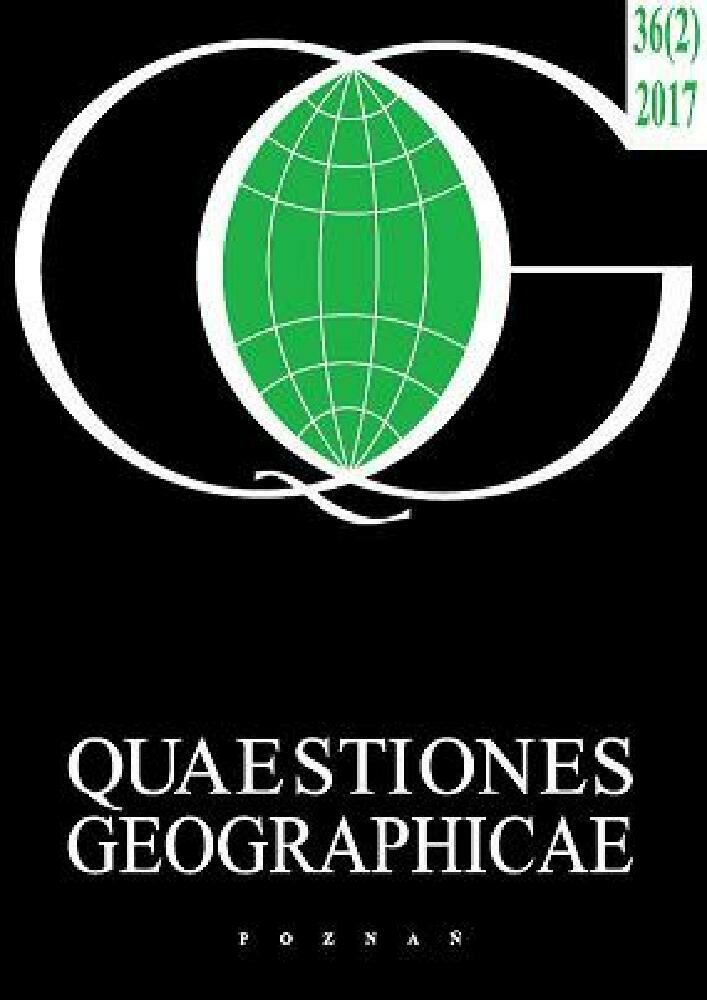Abstract
The Common Agricultural Policy of the European Union is reflected in the development of agricultural production in Slovakia. The development of livestock production faced significant changes reflected in its overall decrease. The decrease in the level of agricultural production in Slovakia between 2002 and 2010 is shown by several indicators assessed in this paper. Its main aim is to highlight differences in Slovak agriculture at the level of LAU I, which are districts of Slovakia, according to the selected indicators of agricultural production between 2002 and 2010. We analyse the development of regional differences in Slovak agriculture that have widened under the influence of the EU Common Agricultural Policy. The development of selected indicators of agricultural production was analysed using the change index, which best represents differences in the development of agriculture in the Slovak regions.
References
Bičík I. et al., 2010. Vývoj využití ploch v Česku. Česká geografická společnosť, Praha.
Blacksell M., 2010. Agriculture and landscape in 21st century Europe: The post-communist transition. European Countryside 2(1): 13–24.
Buday Š. et al., 2012. Porovnanie dopadov SPP na vývoj poľnohospodárskej výroby a objem zahraničného obchodu. Výskumný ústav ekonomiky poľnohospodárstva a potravinárstva, Bratislava.
Buchenrieder G., Möllers J. (eds), 2009. Structural change in Europe’s rural regions. Farm livelihoods between subsistence orientation, modernisation and non-farm diversification. Studies on the Agricultural and Food Sector in Central and Eastern Europe, Vol. 49, IAMO , Halle. Online: http://ageconsearch.umn.edu/bitstream/53334/2/IAMO%20studies%20series_vol49.pdf (accessed 18 October 2014).
Buchta S., 2010. Vývojové trendy v oblasti ekonomiky práce v poľnohospodárstve SR. Ekonomika poľnohospodárstva 10(3): 3–10.
Common Agricultural Policy: A partnership between Europe and farmers, 2012. Online: http://ec.europa.eu/agriculture/cap-overview/2012_en.pdf (accessed 11 February 2015).
Csaki C. et al. (eds), 2010. Structural change in agriculture and rural livelihoods: Policy recommendations. Detailed Report, Chapter 4, Project “SCARLED” SSPE-CT-2006-044201. Online: http://www.scarled.eu/uploads/media/SCARLED_D10_2_final_2013_01.pdf (accessed 22 January 2015).
Doucha T., Štolbová M., Lekešová M., 2012. Assessment of support for farms in the Czech less favoured areas with special regards to cattle breeding. European Countryside 4(3): 179–191.
Falťanová N., 2008. Očakávané vplyvy agrárnej politiky EÚ na vývoj poľnohospodárskej výroby SR. Prognostický ústav SAV, Bratislava.
Farm Structure Census 2010 – complete results, 2012. Statistical Office of the Slovak Republic.
Holúbek I., Baco P., Buday Š., 2013. Vplyv transformácie poľnohospodárstva na diverzitu a ochranu krajiny. Univerzita Konštantína Filozofa v Nitre, Nitra.
Kabrda J., Jančák V. 2006. České zemědělství a krajina po vstupu Česka do EU: nový institucionální rámec. XXI. sjezd České geografické společnosti. České Budějovice.
Kołodziejczak A., 2006. Agriculture and the countryside in Poland: Alternative scenarios of change. Quaestiones Geographicae 25(B): 47–52.
Kołodziejczak A., Kossowski T., 2011. Diversification of farming systems in Poland in the years 2006–2009. Quaestiones Geographicae 30(2): 49–56.
Král M., Palasová P., Svobodová H., Věžník A., 2012. Dopady SZP EU na rozvoj zemědělství v centrální části Drahanské vrchoviny. Geographia Cassoviensis 6(2): 78–90.
Kulikowski R., 2005. Agricultural problem areas in Poland, 2002. Moravian Geographical Reports 19(1): 50–60.
Marcinčáková D., 2013. Kvantifikácia regionálnej diferenciácie výkonnosti agrárneho sektora. Ekonomika poľnohospodárstva : Economics of Agriculture 13(3): 72–84.
Marušinec J., Škriečka M., 2009. Analýza systému podpory v pôdohospodárstve. Analýzy – Argumenty – Názory. Pracovné materiály 9. M.E.S.A. 10 – Centrum pre ekonomické a sociálne analýzy, Bratislava.
Némethová J., 2009a. Agropotravinárske štruktúry okresu Nitra. Univerzita Konštantína Filozofa v Nitre, Nitra.
Némethová J., 2009b. Agroštruktúry vysokoprodukčného regiónu Slovenska / Agricultural structures of a highly productive region in Slovakia. Ekonomika poľnohospodárstva: Economics of Agriculture 9(2): 50–58.
Némethová J., 2010. Types of agricultural enterprises in the high production region in Slovakia (sample area of the Nitra district): Typizácia vybraných agrosubjektov vysokoprodukčného regiónu Slovenska (modelové územie okres Nitra). Agricultural Economics 56(1): 25–31.
Némethová J., Dubcová A., Kramáreková H., 2014. The impacts of the European Union’s Common Agricultural Policy in Slovakia. Moravian Geographical Reports 22(4): 51–64.
Prognóza a vízia vývoja Slovenského poľnohospodárstva, Potravinárstva, lesníctva a vidieka, 2008. Online: http://www.mpsr.sk/index.php?start&navID=2&navID2=2&sID=17&id=657 (accessed 8 May 2015).
Ramniceanu I., Ackrill R., 2007. EU rural development policy in the new member states: Promoting multifunctionality. Journal of Rural Studies 23(3): 416–429.
Roosel A., Sepp K., 2010. Monitoring framework for assessing changes of the Estonian rural landscape in adopting European agricultural policies. European Countryside 2(1): 42–59.
Rudnicki R., 2013. Spatial differences in the number of applications for payments under the EU Common Agricultural Policy submitted by agricultural holdings in Poland over the years 2002–2010. Quaestiones Geographicae 32(4): 15–31.
Shucksmith M., Thomson K.J., Roberts D., 2005. CAP and the regions: The territorial impact of Common Agricultural Policy, CABI Publishing, Wallingford (UK). Online: http://books.google.at/books?id=R000DK-1cfIC&pg=PA149&sig=gQNd558qBEe2_BDRqo0tzHyqNg (accessed 9 June 2014).
Spišiak P., 2011. Výskum rurálnej krajiny v posttransformačnom období na Slovensku. Geographia Cassovienssis 5(1): 93–99.
Spišiak P. et al., 2005. Agrorurálne štruktúry Slovenska po roku 1989. Geo-grafika, Bratislava.
Spišiak P., Némethová J., 2008. Agrosubjekty regiónu Nitra vo vzťahu k odberateľom poľnohospodárskych surovín. Geografický časopis 60(1): 63–87.
Střeleček F., Lososová J., Kvapilík J., 2004. Development of livestock in numbers and structure from the regional and administrative aspect. Agricultural Economics 50(2): 47–57.
Svobodová H., 2011. Vývoj zemědělské výroby v České republice pod vlivem společné zemědělské politiky EÚ. Acta regionalia et environmentalica 8(1): 15–21.
Svobodová H., Věžník A., 2011. Impacts of the Common Agricultural Policy of the European Union in the Vysočina region (Czech Republic) by the view of the farmers. Journal of Central European Agriculture 12(4): 733–743.
Uhrinčaťová E., 2011. Effects of the Common Agricultural Policy potential scenarios after 2013 in the Slovak Republic. Agricultural Economics 57(1): 27–34.
Vaishar A., Zapletalová J., 2009. Sustainable development of rural microregions in the Czech borderland. Moravian Geographical Reports 17(4): 34–43.
Věžník A., Konečný O., 2011. Agriculture of the Czech Republic after accession to the EU: regional differentiation. Moravian Geographical Reports 19(1): 50–60.
Věžník A., Král M., Svobodová H., 2013. Agriculture of the Czech Republic in the 21st century: From productivism to post-productivism. Quaestiones Geographicae 32(4): 7–14.
Věžník A., Svobodová H., 2012. Vývoj zemědelství kraje Vysočina pod vlivem spoločné zemědělské politiky EU. Geographia Cassoviensis 6(1): 81–92.
Zaušková Ľ., Midriak R., Krajčovič V., 2012. Dopady transformačného obdobia a obdobia po vstupe Slovenska do EÚ na zmeny využívania poľnohospodárskej krajiny. Ekonomika poľnohospodárstva 12(4): 98–106.
